A research project by Anne Helmond, Catalina Iorga, Alejandro Ortega. Text by Anne Helmond and Catalina Iorga. Project website on the DMI wiki.
From 28 June – 9 July 2010 we organized a Digital Methods Training Certificate Program which is a two-week intensive training and skill acquisition program. This project is one of project outcomes of the first weeks of the DMI Summerschool 2010.
A Protest’s Web
This project aims to comparatively explore the linking modes of one website and two social media platforms used by protesters of the G20 Toronto Summit; the starting point is provided by one of the largest protest groups on Facebook, RESIST TORONTO G20 SUMMIT 2010 (over 6,800 members) and its affiliated Web spaces: the G8/G20 Toronto Community Mobilization website and the @g20mobilize (more than 1,400 followers) Twitter account listed on aforementioned website.
Thus, we ask: ‘What is the platform dependency of the RESIST TORONTO G20 SUMMIT 2010 Facebook group, the G8/G20 Toronto Community Mobilization website and the @g20mobilize Twitter account, respectively?’ In other words, what other Web spaces do the selected social media platforms – Facebook in particular – and website rely on? What are the cross-syndication practices of the Facebook group, its associated site and Twitter account?
Methodology
We looked at the linking practices of the three web spaces used by the G20 Toronto Summit by looking at the outlinks within these three different spaces.
Webspace 1: Facebook
Collect all outlinks from the RESIST TORONTO G20 SUMMIT 2010 Facebook group:
- Go to the separate Links page of the group.
- Manually compile a list of all subpages of the Links page by copying and pasting respective URLs into a separate file.
- Submit the Links subpages URL list to the Link Ripper.
- Insert the Link Ripper output in the Harvester in order to alphabetize the obtained URLs and remove textual descriptions.
- Manually clean the Harvester output by excluding an ‘exclude’ list of previously compiled Facebook interface links (the ‘About’, ‘Advertising’ or ‘Developers’ links on the bottom of the page, to name just a few).
- Extract the host websites of the abomentioned outlink set by inserting the list into the Harvester and checking the ‘Only return hosts’ box.
- Count the URLs in the final list.
- Visualize the results in a tag cloud created with the Tag Cloud Generator.
Webspace 2: Twitter
Collect all outlinks from the @g20mobilize Twitter account:
- Go to the @g20mobilize page on by Twitter.
- Manually select the text column containing all tweets since the first tweet (May 12th, 2010) to the time of data collection (5th of July, 2010).
- Insert the output into the Harvester so as to compile an alphabetical list of the URLs and eliminate additional text.
- Submit the obtained list to the Expand Tiny URLs tool in order to enlarge Twitter-specific short links to full URLs.
- Extract the host websites of the abomentioned outlink set by inserting the list into the Harvester and checking the ‘Only return hosts’ box.
- Count the URLs in the final list.
- Visualize the results in a tag cloud created with the Tag Cloud Generator.
Webspace 3: Official website
Collect all outlinks from the G8/G20 Toronto Community Mobilization website:
- Go to the G8/G20 Toronto Community Mobilization website.
- Manually compile a list of the all the pages of the G8/G20 Toronto Community Mobilization website by copying and pasting respective URLs into a separate file.
- Submit all pages URL list to the Link Ripper.
- Insert the Link Ripper output in the Harvester in order to alphabetize the obtained URLs and remove textual descriptions.
- Manually clean the Harvester output by excluding compiled interface links (e.g. the ‘Calendar’ and ‘Opensource technology advertising’ links on the left and bottom of the page).
- Extract the host websites of the abomentioned outlink set by inserting the list into the Harvester and checking the ‘Only return hosts’ box.
- Count the URLs in the final list.
- Visualize the results in a tag cloud created with the Tag Cloud Generator.
Linking practices visualized per space
In the tagclouds social media platforms (photo, video and document sharing sites, blog platforms and social networking platforms)Â are indicated in orange.
Webspace 1: Facebook
Preliminary Findings and Further Questions
An overview of the harvested outlinks shows that the RESIST TORONTO G20 SUMMIT 2010 Facebook group heavily relies on YouTube; 29% of the links shared by the Facebook group’s members route predominantly to video content, but also channels and users of the video sharing platform.
Another interesting aspect is a certain degree of internal depedency demonstrated through linking to other groups, pages, events or photos within Facebook; this subset of links accounts for 10% of the entire set. In terms of Facebook as a space for activism, a potential question would be: what are the issues present in the Facebook-hosted content that the RESIST TORONTO G20 SUMMIT 2010 links to? More specifically, to what extent do issues brought forth in this particular group overlap with those presented in the linked groups, pages or events? Or, in more generally speaking, does Facebook offer the possibility to create a coherent alternative place for political activism?
Given the resistance online group’s strong reliance on YouTube content, another question that arises is where else on the Web are these videos referenced? That is to say, what actors make use of this particular audio-visual material and in what issue configurations does it reoccur? Furthermore, what are the cross-linking policies of the actors that engage with these videos? Do they link to each other or to issue-specific social media platforms (like the Facebook group or Twitter account analyzed in this work)? Do they refer to mainstream news media or stay within the alternative framework suggested by the results of the Facebook link examination (for instance, links to progressive news outlet rabble.ca constitute almost 10% of entire URL set)?
Webspace 2: Twitter
Preliminary Findings and Further Questions
The most prominent space referenced by @g20mobilize tweet links is the associated G8/G20 Toronto Community Mobilization site with approximately 25% of the 47 links. A second level of internal dependency becomes visible: while the Facebook group maintains a basic level of reliance on other Facebook-hosted material – a phenomenon that can be explained through the opportunity to post content that each group member has -, the Twitter account aligns itself with the official website, potentially alluding to a more centralized, coherent approach due to administration of the account by one person, for example.
Another type of signifcant allegiance is to the idea of ‘alternative reporting’ proposed by the G20 Alt Media Center, a website that encourages protesters to tag social media platform posts – on YouTube, Flickr or Twitter – with ‘#g20report’. This is reflected not only by the fact that 16% of the URL set directs to the Toronto Media Coop, the official news provider on the G20 Alt Media Center frontpage, but also by the ubiquity the abovementioned ‘#g20report’ tag, which is present in 62% of tweets.
However, it should be taken into account that only 12% of Twitter posts actually link to other pages. In addition to this, nearly half – 44%, to be specific – of the tweets were posted during the 26th and 27th of June, respectively, the official G20 Toronto Summit conference dates. Considering these two aspects – the scarcity of links and the event-focused approach -, it could be hypothesised that the @g20mobilize account is a temporally-anchored platform, aimed at taking the pulse of the ‘here’ and ‘now’. A question that follows from this assumption is: what are the issues and actors mentioned in the @g20mobilize‘s version of the protests? Is the Twitter account used as a means of information, a support rallying tool, or both?
Webspace 3: Official website
Preliminary Findings and Further Questions
Of particular interest is that, similarly to @g20mobilize, the website does not refer to Facebook – though there is a constant right-hand link in the website’s template – and YouTube to the same extent shown by the RESIST TORONTO G20 SUMMIT 2010 Facebook group refers to YouTube and Facebook itself. In other words, there seems to be a certain degree of linking dissonance in the G20 Toronto Summit cross-syndication practices; while the Facebook group, as a social media platform, heavily relies on other social media platforms, both the @g20mobilize account and the G8/G20 Toronto Community Mobilization site mostly refer to official partners such as the latter Web space and Toronto Media Coop, respectively.
The Toronto Media Coop, an indicator of ‘alternative reporting’ as explained above, appears to be a slightly more prominent space, but not significantly due to the relatively low number of mentions, which accounts for only 4.54% of the total number of links. Nevertheless, the even outlink distribution portrayed by the tag cloud points to another question: what is the relationship between the mainstream media (such as the localToronto CTV or the Toronto Star) and alternative entities (Toronto Media Coop and The 2010 People’s Summit, a civil society alternative “counter Summitâ€)? Does ‘alternative reporting’ make use of established news resources? Does mainstream journalism acknowledge alternative online spaces?
Linking Practices Compared
The next step in looking at platform dependency of the three spaces is a cross-comparitive analysis of their linking practices. To what extend do the webspaces for organizing and informing about the G20 protests rely on social media platforms? What are the shared platforms by the three media spaces and who are the common actors?
Method
- Input all three final link sets into the Triangulate tool.
- Extract the common links.
- Visualize the results by manually creating a matrix that vertically features the three platforms and horizontally displays the set of linking commonalities. In order to compare the amount of links in an equitable fashion, the bubbles are scaled proportionally; for example, out of Facebook’s total of 627 links, 182 link to YouTube, yielding 29% of the set. Normalization of the dataset.
Preliminary Findings and Further Questions
RESIST TORONTO G20 SUMMIT 2010, @g20mobilize, G8/G20 Toronto Community Mobilization have six common Web spaces in their outlink sets: two social media/ content-sharing platforms (Facebook and YouTube), the websites of two mainstream, Toronto-based newspapers (the Toronto Star, and the Globe and Mail), and last but not least, the alternative, collaborative online news source Media Coop. This heterogeneous mix of mainstream coverage, alternative reporting, but also exclusively online news sources, Web instatiations of print and television entities, and sharing platforms deserves further investigation. A question to be followed upon is: what are the linking modes of the six most prominent spaces in the cross-syndication of G20 Toronto Summit protest content?
From the preliminary findings we can formulate several larger issues that may be addressed for further research: First, the self-referentiality of Facebook has media effects: does using Facebook constrain to a single platform? On top of Facebook’s internal dependency it heavily relies on content hosted on the videosharing platform YouTube. Within the Facebook group YouTube is heavily linked to, however YouTube does not link out (linking practices within YouTube mainly occur in the comments). Hypothesis: Content platforms are self-referential and do not link outside. Second, the hypothesis that the further we move away from 2.0 technologies/social media the less you refer to them.
Further research
Given the prominence of YouTube within the Facebook group and it’s presence in the two other web spaces, where else are the YouTube videos that are referred to located? What are the other platforms, besides Facebook, where this content is syndicated?
Method: collect all inlinks to the YouTube movies and visualize linking websites in a tagcloud (in a next version all similar top-level-dmains should be merged, eg. national Facebook versions should be merged into Facebook.com).
Project presentation file
[slideshare id=5163489&doc=g20cross-100909072944-phpapp01]
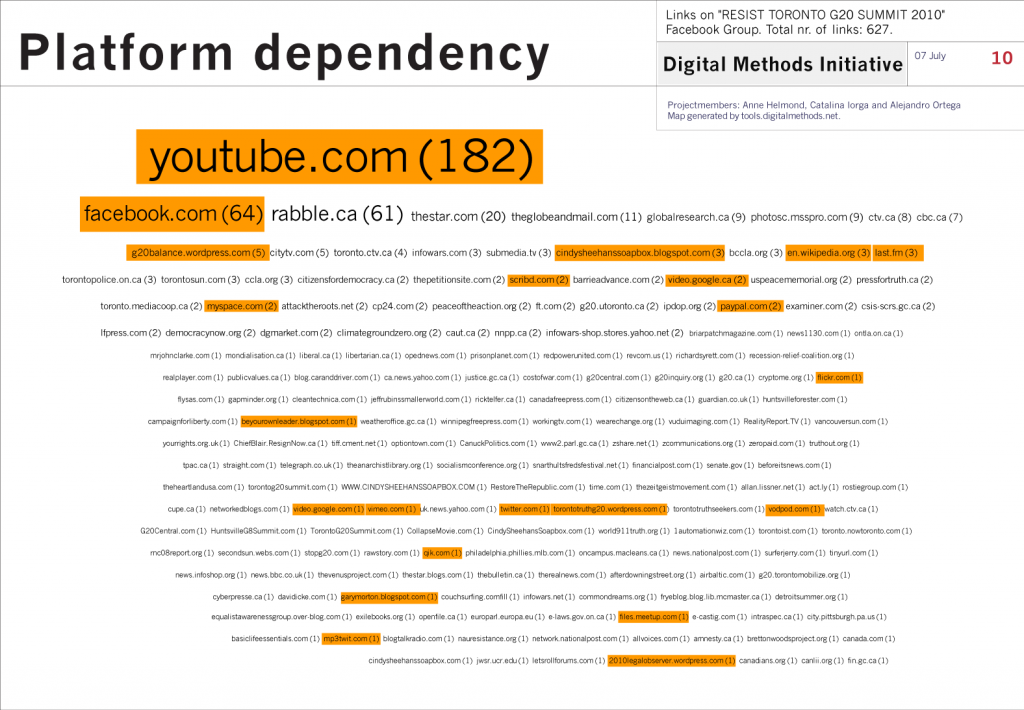
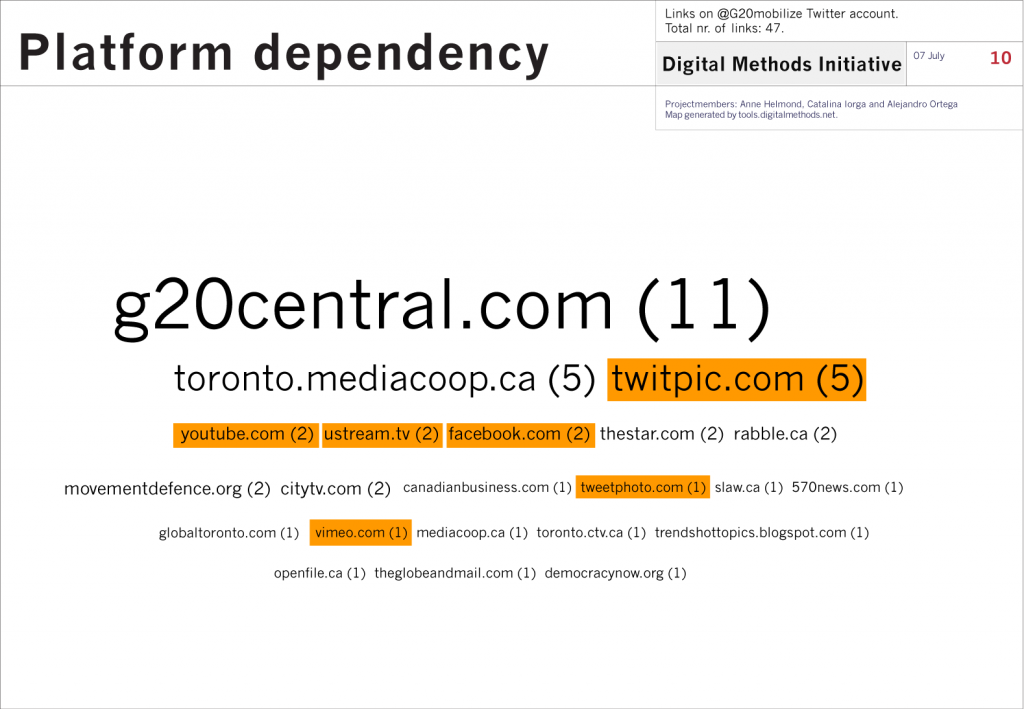
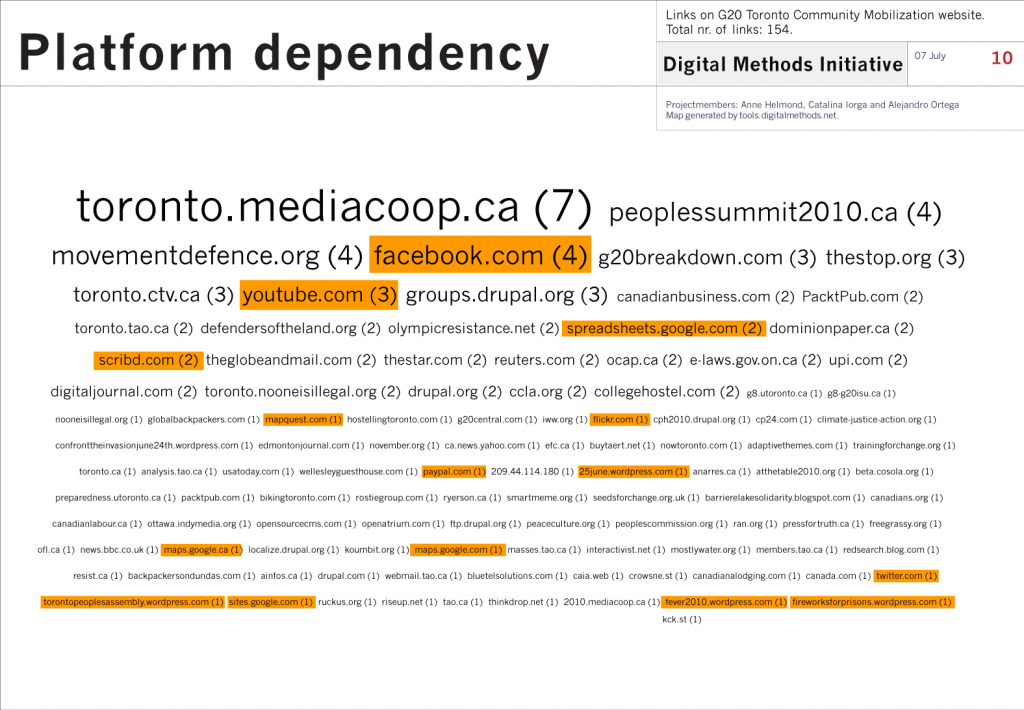
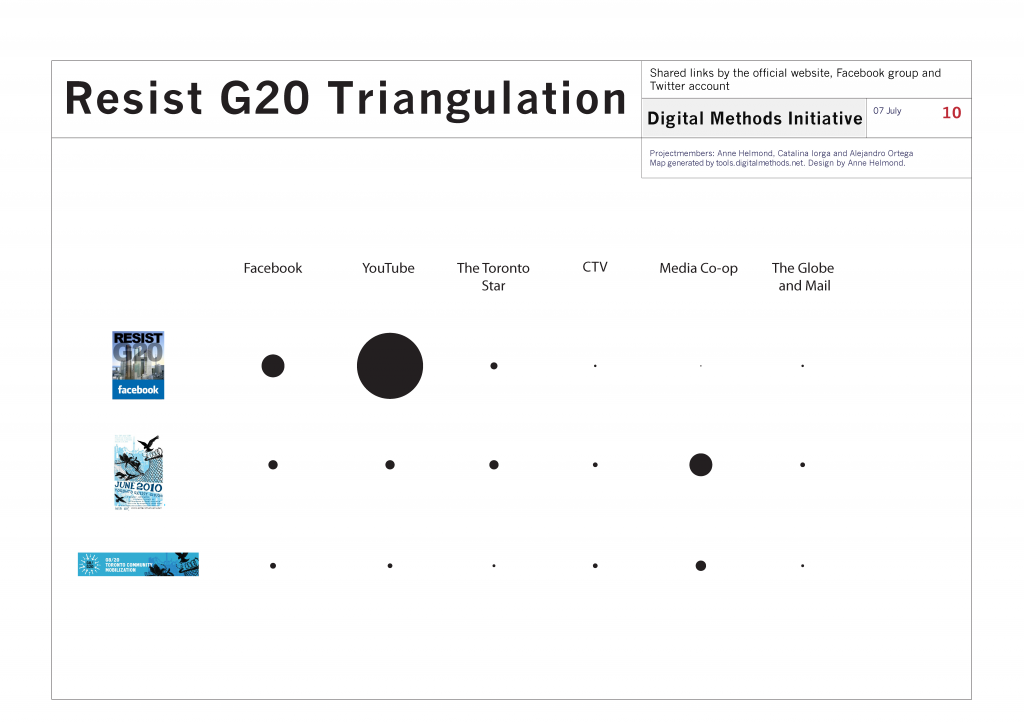

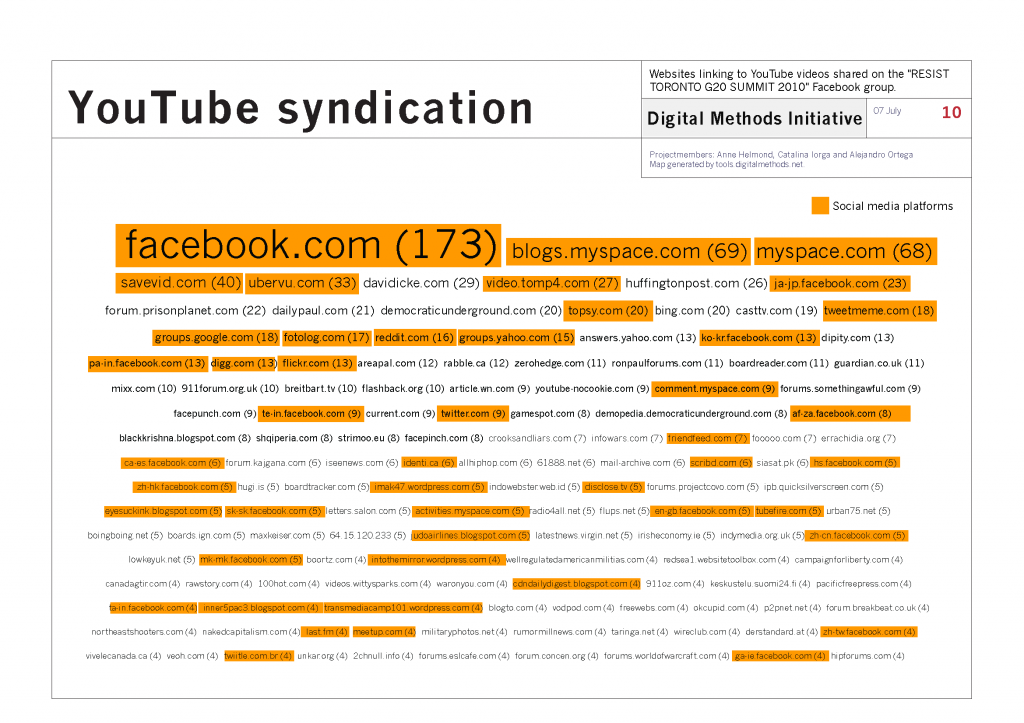
Interesting finding – and one we’ll discuss here in Toronto. One thing your paper can’t show is that the Resist Toronto site wasn’t organized locally and was in conflict with the local organizers. But they were the first ones on facebook and got the largest number of ‘friends’. cheers, Lesley
Lesley & Justin: Thank you very much for these useful comments. Our research indeed started from the largest Resist G20 group and looked at which websites they affiliated themselves with which were http://www.stopg20.com and http://www.g20central.com. At the time of the research the website http://www.g20central.com redirected to http://g20.torontomobilize.org/ which was -wrongly- assumed as an alliance. The http://www.g20central.com now seems to be a spam portal :( Thank you for pointing out that these sites are not aligned but actually in conflict. We hope to do a follow-up research project that takes that into account.
Justin: This research project only focussed on data available on the web and as such tried to sketch the online media ecology of this group. Taking other organizational forms and interactions into account would indeed enrich the research.
Quite interesting, although including information that doesn’t readily lend itself to web analytics would result in a somewhat fuller understanding of these questions, I think.